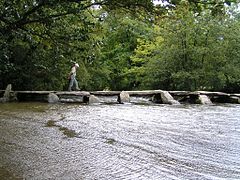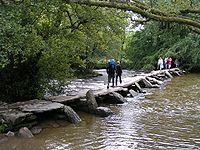Tarr Steps
| Tarr Steps | |
| Somerset | |
|---|---|
 The Tarr Steps, viewed from downstream | |
| Location | |
| Type: | clapper bridge |
| Carrying: | footpath |
| Crossing: | River Barle |
| Location | |
| Grid reference: | SS867321 |
| Location: | 51°4’37"N, 3°37’5"W |
| Structure | |
| Length: | 180 feet |
| Type: | clapper bridge |
| Material: | stone slabs
₨ |
| History | |
| Information | |
The Tarr Steps are a clapper bridge across the River Barle on the Exmoor in Somerset.[1] They are located in a national nature reserve about two and a half miles south-east of Withypool and four miles north-west of Dulverton.
A typical clapper bridge construction, the bridge's listing assesses it as mediæval in origin, though it is also claimed to be prehistoric. The stone slabs weigh up to two tons each. According to local legend, they were placed by the devil to win a bet.
The bridge is 180 feet long in all and has 17 spans.[2] It has been designated as a grade I listed structure and a Scheduled Ancient Monument.[1][3]
Half of the bridge was washed away by the river whilst heavily swollen by rain in December 2012 and was re-assembled.[4] It was damaged again in November 2016 and will, according to Somerset County Council be rebuilt again.
Well marked footpaths run along the valley between Simonsbath and Dulverton and to the village of Withypool. There is a circular walk from the main car park for Tarr Steps down to the river, along the riverbank for just under a mile to a footbridge and returning on the other side, crossing the river on the clapper bridge. The main car park (400 yards from the bridge across a footpath) can be reached from the B3223 road between Withypool and Dulverton. Parking for the disabled and refreshments are available nearer the bridge, as are information panels put up by the Exmoor National Park, giving details of Tarr Steps history and design.
The bridge

The bridge is of an ancient form, constructed with large unmortared slabs of stone resting on one another, and this is the largest example of its type. There are 17 spans across 60 yards. The top slabs weigh 1-2 tons and are about 39 inches above normal water level. The largest slab is over eight feet long and is about five feet wide.[5] This is one of the best known monuments on Exmoor. Its age is unknown, as several theories claim that Tarr Steps dates from the Bronze Age but others date them from around 1400 AD. It has been restored several times in recent years, following flood damage. Over the years the damage provides a good indicator of the strength of each flood. Some of the top slabs have been washed away in extreme flood conditions and they have now all been numbered to facilitate replacement.
The bridge was badly damaged by floodwater on 22 December 2012 when steel wires upstream (designed to protect the bridge from damaging debris) were broken by fallen trees washed down the river.[4][6][7] The bridge was damaged by floodwater again on 21 November 2016 and is awaiting reconstruction once river levels permit.[8]
Myth
Myth has it that the Devil built the bridge at Tarr Steps and still has sunbathing rights on its stones. The myth says that the devil swore he would kill anyone who tried to cross his bridge. The terrified locals got the parson to face him. A cat was sent over the Bridge but was vaporised in a puff of smoke. The parson then set off and met the Devil midway. The Devil swore and intimidated him but the parson reciprocated equally and finally the Devil conceded to let people pass except when he wants to sunbathe.[9]
Outside links
| ("Wikimedia Commons" has material about Tarr Steps) |
- Historic photos of Tarr Steps
- Images of England — details from listed building database (429207) Tarr Steps
- Megalithic Portal: Tarr Steps
- www.exmoor-nationalpark.gov.uk - information on Tarr Steps floods
References
- ↑ 1.0 1.1 Images of England — details from listed building database (429207) Tarr Steps
- ↑ Leete-Hodge, Lornie (1985). Curiosities of Somerset. Bodmin: Bossiney Books. pp. 63–64. ISBN 0-906456-98-3.
- ↑ Tarr Steps&nbps;- Heritage Gateway
- ↑ 4.0 4.1 "One of Britains oldest bridges swept away by floodwater". Telegraph. http://www.telegraph.co.uk/topics/weather/9772445/One-of-Britains-oldest-bridges-swept-away-by-floodwater-as-more-rain-forecast-over-New-Year.html. Retrieved 31 December 2012.
- ↑ Otter, R.A.: 'Civil Engineering Heritage: Southern England' (Thomas Telford Ltd, 1994) page 92, ISBN 978-0-7277-1971-3
- ↑ "1,000-year-old bridge at Tarr Steps washed away in Exmoor floods, the stones have now been replaced.". This is Somerset. http://www.thisissomerset.co.uk/1-000-year-old-bridge-Tarr-Steps-washed-away/story-17724546-detail/story.html. Retrieved 31 December 2012.
- ↑ "Mediæval clapper bridge swept away in flood". The History Blog. http://www.thehistoryblog.com/archives/22580. Retrieved 3 January 2013.
- ↑ "Exmoor's Tarr Steps partly washed away by floodwater" (in en-GB). BBC News. 21 November 2016. http://www.bbc.co.uk/news/uk-england-somerset-38051705. Retrieved 21 November 2016.
- ↑ Warren, Derrick (2005). Curious Somerset. Stroud: Sutton Publishing. pp. 66–67. ISBN 978-0-7509-4057-3.
